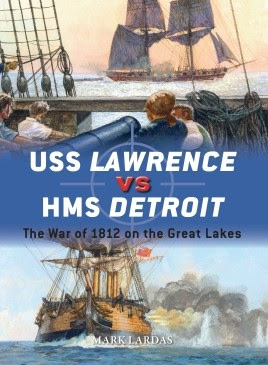Flashpoint Trieste: The First Battle of the Cold War
Flashpoint Trieste is the story of one year in one city as the Cold War begins. The Western Allies had captured the Adriatic port city before the Russians could reach it, but having survived the war, everybody is now desperate to make it through the liberation. Life is fast and violent, as former warring parties find common cause against the Soviet Union and the borders of the new Europe are being hammered out. Against this deadly backdrop of intelligence operations, escape and revenge, the British and Americans are locked into the opening salvoes of the Cold War on the beautiful shores of the Adriatic, opposing the Russians and Yugoslavs.
This is the story of the first turbulent post-war year of lethal cat-and-mouse in south-eastern Europe, told through the stories of twelve men and women from seven different countries thrown together on a strategically vital frontier between East and West.
USS Lawrence vs HMS Detroit
The most critical naval fighting during the War of 1812 took place, not on the high seas, but on the inland lakes of North America: the Great Lakes and Lake Champlain. Carrying between 12 and 22 cannon, the British and American sloops-of-war were ship-rigged, brig-rigged or schooner-rigged vessels. Lakes actions often involved two ships facing each other broadside to broadside, the best example of which was the battle of Lake Erie in 1813 where HMS Detroit led a Royal Navy squadron against the USS Lawrence-led US Navy.
Featuring full-colour artwork, this lively study investigates the prolonged struggle between British and US sloops-of-war, highlighting the differences between the war on the lakes and the war on the oceans during the Age of Fighting Sail. It reveals the circumstances under which these ships were built, how they were armed, and the human story behind their construction and use in battle.
Ju 52/3m Bomber and Transport Units 1936-41
The all-metal Junkers Ju 52/3m enjoyed a solid - indeed, revered - reputation amongst its crews and the troops and paratroopers who used and depended on it. For more than ten years, it saw service as a successful military transport, with its distinctive, three-engined design and corrugated metal construction becoming instantly recognisable. It was a mainstay in the Luftwaffe's inventory, first seeing service in the 1930s in bombing and transport operations in the Spanish Civil War, and subsequently during the German invasion of Poland. It then served on every front on which the Luftwaffe was deployed until May 1945.
The Junkers served as a stalwart transport, confronting both freezing temperatures and ice, and heat and dust, lifting men, animals, food and supplies vital for German military operations. This, the first of two books on the Ju 52/3m, details its service as a bomber in Spain and in South America, followed by its pivotal role in early war operations during the invasions of Poland and France, the airborne invasion of Crete and the early stages of Operation Barbarossa.
Longbowman vs Crossbowman
For centuries, the crossbow had played a key role on the battlefields of continental Europe, with mercenaries from Genoa and Brabant in particular filling the ranks of the French army, yet on the outbreak of the Hundred Years' War they came up against a more powerful foe. To master the English longbow was a labour of years, requiring far greater skill to use than the crossbow, but it was much more flexible and formidable, striking fear into the French and their allies.
This study examines three battles - Sluys (1340), Crécy (1346) and Poitiers (1356) - and shows how the use of the longbow allowed England's armies to inflict crushing defeats on numerically superior forces. The longbow changed the shape of war, becoming the defining weapon of the age and wreaking havoc upon the French armies that would face it. Featuring full-colour artwork, this is the engrossing story of the first clashes between the English longbowmen and the crossbowmen of the French king on the bloody battlefields of the Hundred Years' War.
North American X-15
The revolutionary X-15 remains the fastest manned aircraft ever to fly. Built in the two decades following World War II, it was the most successful of the high-speed X-planes. The only recently broken ‘sound barrier' was smashed completely by the X-15, which could hit Mach 6.7 and soar to altitudes above 350,000ft, beyond the edge of space. Several pilots qualified as astronauts by flying above 50 miles altitude in the X-15, including Neil Armstrong, the first man on the Moon. The three X-15s made 199 flights, testing new technologies and techniques which greatly eased America's entry into manned space travel, and made the Apollo missions and Space Shuttle viable propositions. With historical photographs and stunning digital artwork, this is the story of arguably the greatest of the X-Planes.
Fontenoy 1745
A disputed succession to the Austrian throne led to general war between the leading powers of Europe in 1740, with France, Spain and Prussia on one side, and Britain, Habsburg Austria and the Dutch Republic on the other. While fighting occurred across the globe, the bloodiest battles were fought on the European continent, with none more costly than the battle of Fontenoy in 1745.
Fearing an encirclement of France by a resurgent Habsburg-controlled Austria, the French commander Marshall Saxe planned to overrun the Austrian Netherlands, thereby dealing a decisive blow against their enemy's ability to wage war. Saxe's army, the cream of the French military, invaded and set up a defensive position at Fontenoy, near Tournai - daring his enemies to knock him off his perch. This title, beautifully illustrated with full colour plates, is an in-depth study of the British Duke of Cumberland's attempt to assault Saxe's position. It focuses on the inability of allied leaders to coordinate their attacks and how Cumberland came within a whisker of achieving a major victory.
The Pilum
A heavy javelin, normally used as a shock weapon immediately before contact, the pilum was designed with a particular speciality: it could penetrate a shield and carry on into the individual behind it. Relying on mass rather than velocity, at short range a volley of pila had much the same effect on a charging enemy as musketry would in later periods. The design was not uniform, with a wide diversity of types throughout the developmental history of the weapon, but for more than four centuries it remained a vital part of the arsenal of weapons at the disposal of the Roman legionary.
Drawing upon recent major finds in the Iberian Peninsula and the Balkans, as well as written records and rigorous scientific analysis, this enthralling study lifts the veil on the evolving nature of the pilum, the Roman heavy javelin that helped to conquer the known world.
Roman Army Units in the Eastern Provinces (1)
Between the reigns of Augustus and Septimius Severus, the Eastern provinces of the Roman Empire frequently saw brutal fighting, most notably during the conquest of Dacia by Trajan, the suppression of the Great Revolt in Judea and intermittent clashes with Rome's great rival Parthia. In these wars, Roman soldiers had to fight in a range of different climates and terrains, from the deserts of the Middle East to the islands of the eastern Mediterranean.
Using full-colour artwork, this book examines the variation of equipment and uniforms both between different military units, and in armies stationed in different regions of the Empire. Using evidence drawn from recent archaeological finds, it paints a vivid portrait of Roman army units in the Eastern provinces in the first two centuries of the Imperial period.
Bolt Action: Campaign: Sea Lion
The year is 1940, and the German invasion of Britain has begun. With this new campaign book for Bolt Action, players can fight the battles of World War II's greatest ‘what if' scenario. Defend the cliffs of Dover and the beaches of Kent from wave after wave of German landing craft. Parachute into the Home Counties in a surgical strike to capture Winston Churchill. Rally the Home Guard in a last, desperate attempt to keep England free of the Nazi invaders! Containing new rules, scenarios, and unit types covering all of the unique features of this alternate history campaign, it offers a chance for all Bolt Action players to truly rewrite the history of World War II.
The History of the Panzerwaffe
The final years of World War II saw the legendary Panzerwaffe face its most difficult challenges, with Allied troops landing at Normandy and storming across the continent and the Russians gaining the upper hand on the Eastern Front. As Germany fought fiercely to hold on to the advantages gained in the early years, they relied heavily on the Panzer IV, the Panzer V Panther and the StuG III - the backbone of their infamous armoured divisions - to hold back their advancing opponents. This second volume on the Panzerwaffe offers a comprehensive guide to the final years of Germany's most famous fighting force, covering the further use of the Panzer IV, the role played by the StuG III assault gun and the battlefield debut of the formidable Panther. Explosive combat reports and rare archive photographs help uncover the final years of the Panzers, from their defence against the D-Day landings and the role they played in the Ardennes Offensive to their valiant last stand in Berlin.
Hurricane
2017 marks the 80th anniversary of the remarkable Hawker Hurricane formally entering service. The RAF's first monoplane fighter, it dragged the Air Force into a position where it could defend Britain in her 'hour of need'. The true workhorse of the RAF, the Hurricane came into its own in the hot summer months of 1940 valiantly defending the skies above Britain. Outnumbering Spitfires three to one, the Hurricane also downed far more enemy aircraft. Without the obvious elegance of the Me 109 or the Spitfire, the Hurricane was nonetheless beloved by its pilots for its ability to simultaneously take a battering and inflict serious damage from its remarkably stable gun platform. This stunning new book reveals the Hurricane in all its glory - from fascinating first-hand accounts from the men who flew her to the truly breathtaking images from John Dibbs of the Hurricanes still in flight today. This lavish, fully illustrated edition is a must-have for all fans of aviation history.











No comments:
Post a Comment